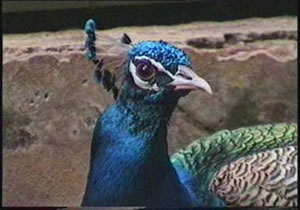By - Shivani Thakur
As we celebrate of our Independence Day, our freedom reminds us of the sorry state of our national bird and national animal. Both are under Schedule1 of Wildlife Protection Act 1972. Although the disappearance of Tigers has jolted
the Ministry of Environment to set up task force, the Peacock is still getting the step-motherly treatment.
 The male Peacock (Pavo cristaus) is a swan sized bird with a fan shaped crest of feathers, a white patch under the eye and long slender neck. The male of the species is more colorful than female with a glistening blue breast and
neck and elongated feathers. The female is brownish, slightly smaller than the male and lacks the train. The Peacocks belong to the pheasant family and largely found in the Indian sub-continent -to the south and east of Indus river, in Jammu and Kashmir, east
Assam, south Mizoram and other places. The heavy peacock concentration is found in Harayana, Punjab,Rajasthan ,Delhi,Gujrat and U.P. It is believed to be a harbinger of the approaching monsoon with its elaborate courtship dance seen all over the country before
the rains. Many associate this bird with fertility and good luck. Its status as the 'vahan' of Kartikeya, son of Lord of Shiva and its role in Hindu mythology has offered its some immunity over the years. But unfortunately this is fast changing.
The male Peacock (Pavo cristaus) is a swan sized bird with a fan shaped crest of feathers, a white patch under the eye and long slender neck. The male of the species is more colorful than female with a glistening blue breast and
neck and elongated feathers. The female is brownish, slightly smaller than the male and lacks the train. The Peacocks belong to the pheasant family and largely found in the Indian sub-continent -to the south and east of Indus river, in Jammu and Kashmir, east
Assam, south Mizoram and other places. The heavy peacock concentration is found in Harayana, Punjab,Rajasthan ,Delhi,Gujrat and U.P. It is believed to be a harbinger of the approaching monsoon with its elaborate courtship dance seen all over the country before
the rains. Many associate this bird with fertility and good luck. Its status as the 'vahan' of Kartikeya, son of Lord of Shiva and its role in Hindu mythology has offered its some immunity over the years. But unfortunately this is fast changing.
Today, its population under threat due to habitat destruction, poaching and contamination of food source. Ironically, until today no census has been conducted of the peacock. The sole stock taking of the peacock population was done by
WWF India in 1991. According to detailed examination conducted by Chowdhary Charan Singh of Hissar Agricultural University in Haryana, the deaths of peafowls reported in village Rampura in Mahendragarh on Dec 2 ,1999, was due to consumption of seeds treated
with pesticide 24D,a weedicide. The Earth Island Journal reported death of peacocks is due to Chlorpyriphos toxicity .The birds eat seeds which are treated with this pesticide. But the mortality was among male peacocks only who fell from trees, unable to fly.
The other cause is poaching done for their beautiful feathers and even for fat, which is erroneously believed to be useful in treatment of arthritis. Poaching is also one for white meat. While the young ones are trapped for eating, male
peacocks are killed for feathers. Although law permits collecting of moulted feathers, most of the time the case is not so. Most of peacocks are killed during mating season when it is easier to locate them as they dance in the open. It is also easier to hunt
them because they sleep in the same trees every night. The killing procedure is also barbaric where the birds are first trapped, legs broken, feathers pulled out and later on killed.
Peacocks and other birds play a crucial role in the food chain. By feeding on insects and controlling weeds, they increase the nitrogen content of the soil. Yet their effective role is being sidelined for the immense beauty they possess.
Time is not far when we Indians would no longer be proud as Peacocks.
(Photograph of peacock- Susan Sharma: Buy a VCD about the peacock byclicking here)